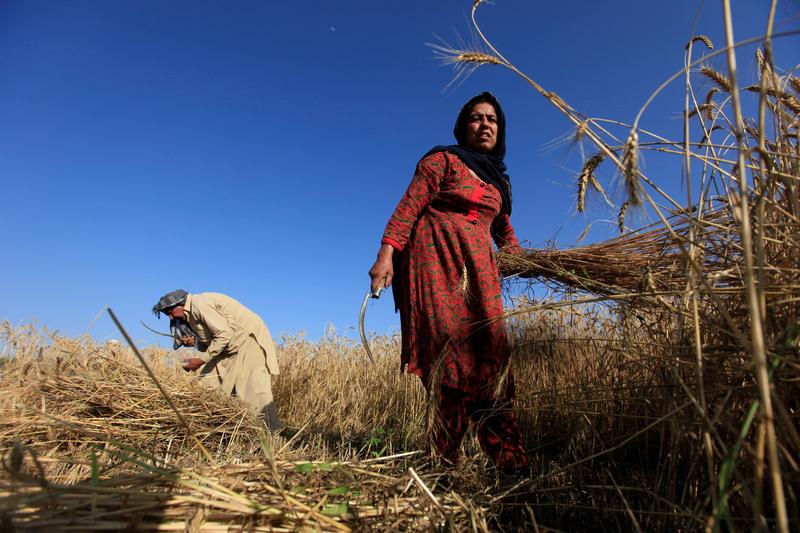Climate journalists need persistence to get good data, including from governments

Farmers harvest wheat at a field on the outskirts of Islamabad in April 2018. Credit: Faisal Mahmood/Reuters.
In April 2022, a sudden change in the weather pattern was observed in Pakistan: temperatures were rising rapidly. Here, summer usually begins in May, but last year, it arrived weeks early. The spring flowers vanished earlier than usual. The government warned that the change in the weather might have direct consequences for wheat, the country’s main staple crop.
I began reporting on the impacts of the strange weather on crops for The News on Sunday, a prominent weekly magazine, but I quickly encountered a barrier. It took me four weeks to collect the wheat yield data in Khyber Pakhtunkhwa, a province in the country’s northwest, where I live. The officials were reluctant to share the numbers.
After finally receiving the data, I began searching for the latest domestic scientific research on how extreme weather events affected crops. But I couldn’t get the local scientific research – it didn’t exist.
It wasn’t the first time I had struggled to get basic climate and weather information from my own government. For Pakistani journalists, simply getting climate change-related data is a herculean task. But climate journalists always need to persist in getting the basic facts, including relying on inside sources, using requests for public data, and relying on farmers who can observe changes in weather patterns.
In the last 10 years, I’ve seen the underground water table in several districts of Khyber Pakhtunkhwa drop so low that in the Mohmand, Khyber, and Kurram districts wells had dried up, and residents were forced to buy water brought in by tankers.
Now I needed the official figures to back this up. The previous year, Pakistan’s Ministry of Water Resources had submitted a report to the Senate’s Standing Committee on Climate Change. The report contained some shocking numbers. But when I requested the report, it was declined by officials in the ministry. After coordinating for several weeks, I finally managed to get the report through a source.
The impact of the floods
The difficulty of getting climate and weather data became obvious to the world just months after my story on the wheat yields, with the arrival of the historic 2022 floods. A USAID factsheet has estimated that at least 1,739 people died as a result of the floods, while 33 million people were affected, and millions of houses, livestock, and significant communication infrastructure were destroyed.
The national and international media covered the flood devastation extensively. But due to the lack of data, it was very difficult for reporters and newsroom managers to cover the causes of this devastation, and track how the government acted afterwards. The government damage assessment survey took six months, and still has complications: many of those affected are still waiting for compensation. One year later, we still see a lack of follow-up investigations and long-form stories from the flood-hit areas.
To get access to official data for such stories we have two main options. The first is to rely on sources in the different government departments, and the second is to file a Right to Information request. But getting a reply often takes months. When neither option produces information, we have to rely on international sources for climate data that don’t necessarily have the level of detail or local knowledge that we need.
Reporters also struggle to find researchers with local knowledge. Asif Khan, an environmental journalist working for Lakki Broadcasting, says that for a piece on extreme weather events in the Khyber Pakhtunkhwa province, he contacted the Provincial Disaster Management Authority. But the data on the subject was not available. Khan also struggled to find an expert in the local language who could explain the impacts of extreme weather events.
He had no option but to use the Intergovernmental Panel on Climate Change (IPCC)’s latest report as his main source. When Khan was covering climate change and its impact on the economy, he had to rely on World Bank reports.
Fawad Ali, a freelance environmental journalist with the Third Pole, says unfortunately one of the reasons it’s so difficult to get good climate information from local governments in Pakistan is partly because many officials still don’t accept that climate change is a reality.
When he was working on a story on groundwater depletion in Khyber Pakhtunkhwa, the concerned officials were not willing to cooperate. He used his connections and gathered data from different government departments, but found their data contradicted itself, even though it was collected by a single consultant hired by the same government.
These are all major barriers to producing climate journalism in Pakistan. But all of these journalists got the job done. They relied on a mix of local sources, including building a strong bond with farmers who record changes in weather patterns, sources inside governments, and using international data. International collaboration with other journalists and the rise of accessible technology is another major tool: real-time satellite data has given us access to information when the government won’t.
Ultimately, the main thing climate journalists need is persistence and creativity. There are many challenges while covering climate change related stories in a country like Pakistan, but you always need to think and work outside of the box.
In every email we send you'll find original reporting, evidence-based insights, online seminars and readings curated from 100s of sources - all in 5 minutes.
- Twice a week
- More than 20,000 people receive it
- Unsubscribe any time




